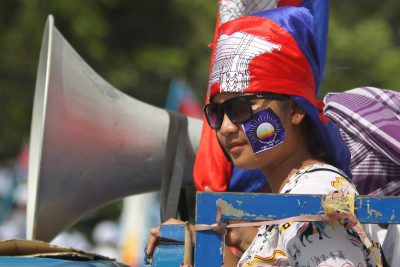The looming dissolution of the CNRP follows the September arrest of opposition leader Kem Sokha, the flight from the country of leading CNRP parliament members and a clampdown on the press.
Promising the de facto return to one-party rule, the recent political crackdown is indisputably the most serious assault on Cambodian democracy since the 1993 reintroduction of multi-party elections.
The sheer nerve of the incumbent Cambodian People’s Party (CPP) in invalidating nearly 3 million votes came as a surprise. Until now, the move was considered so unlikely that each successive CPP step to weaken the opposition has been interpreted as an attempt to gain a bargaining chip rather than an overture to foreclose electoral competition outright.
But it is now hard to believe anything but that the CPP is delivering its final blow to the opposition according to a long-term strategy that spans its entire mandate.
Following the post-election protests of 2013–14, which were violently broken up, the CPP neutralised the CNRP through a one year ‘culture of dialogue’ that reined in CNRP’s tough rhetoric. After that, consensual politics were replaced by attacks on a weakened opposition. While recent local elections offered a period of relative calm — presumably because the CPP aimed to test its electoral strength — the CPP is now putting in motion the machinery of legal measures that they have carefully introduced through legislative changes over the past few months.
Political change of some sort in Cambodia has an aura of inevitability since the 2013 elections. This is an aura that the CNRP has fought hard to project, and which the CPP has now unravelled. The CPP is gambling on the presumption that the 44 per cent of voters whose votes were invalidated will not take political action. This is important given that the CNRP has a strong support base among the almost two-thirds of the population who are below the age of 30. Lacking memories of the Khmer Rouge regime, which the precursor to the CPP toppled, Cambodian youth are both less grateful to the CPP and less fearful than their elders. The CPP is putting this emerging fearlessness to the test, and the outcome is unpredictable. The lack of a strong domestic reaction to the undemocratic measures put in place so far opens up a new range of until now unimaginable political possibilities for the emboldened CPP.
With eight months to go until national elections, the previously unthinkable scenario that the CPP will be the only main party to contest the 2018 elections now looms. The crackdown does leave a window open for a resolution allowing the weakened opposition to contest the 2018 elections, perhaps under a different name and with a partly different leadership. The CPP could court elements of the CNRP leadership to head a salvaged party, similar to how Ung Huot replaced Ranariddh as first Cambodian prime minister in 1997. If deemed unthreatening, a defanged opposition could be allowed to contest the elections to give an outlet for oppositional energies and a boost to the CPP’s electoral legitimacy.
Its imminent outlawing marks the logical endpoint of the CNRP’s position to obey the rule-of-law designed by the CPP. To continue to exist, the CNRP would have to renege on its twin constraints: bending to the legal framework defined by the CPP and avoiding the possibility of violent confrontation at all costs.
To have a real shot at regime change through elections rather than merely nominal inclusion in some form on electoral rolls, the CNRP would have to find its way back to connect with the electorate in the streets. Capitalising on the party’s dissolution to create popular momentum may be a hard but not impossible feat. The opposition managed to quietly build support in a repressive climate ahead of the 2013 election, and then in that year’s electoral campaign galvanised oppositional energies through mass gatherings. Last year, two and a half years after mass demonstrations came to an end, an estimated 2 million people turned up for the funeral procession of the assassinated government critic Kem Ley.
The CNRP has so far placed its hopes in growing international pressure. But this hope may be in vain, with Hun Sen trying to kill two birds with one stone: the CNRP are accused of conspiring with Western governments and media outlets, which makes Western criticism of the 2018 election wholly irrelevant. From the Cambodian government’s perspective, the transition to a stance backed by China to turn away from the West may now be complete. Whether severe economic and diplomatic consequences could reverse the CPP’s course of action will now be put to the test.
The logic of the situation will compel the CPP to maintain its strong-arm tactics up until the election despite increasing popular alienation. There is no authoritarian nostalgia in Cambodia like that in the Philippines or Thailand. This makes the ongoing crackdown more out of tune with public sentiment and potentially more volatile.
Astrid Norén-Nilsson is an Associate Senior Lecturer at the Centre for East and South-East Asian Studies, Lund University and author of Cambodia’s Second Kingdom: Nation, Imagination, and Democracy.

